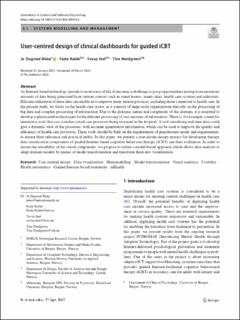| dc.contributor.author | Wake, Jo Dugstad | |
| dc.contributor.author | Rabbi, Fazle | |
| dc.contributor.author | Inal, Yavuz | |
| dc.contributor.author | Nordgreen, Tine | |
| dc.date.accessioned | 2022-06-08T09:33:29Z | |
| dc.date.available | 2022-06-08T09:33:29Z | |
| dc.date.created | 2022-04-27T15:20:23Z | |
| dc.date.issued | 2022 | |
| dc.identifier.issn | 1614-5046 | |
| dc.identifier.uri | https://hdl.handle.net/11250/2997838 | |
| dc.description.abstract | As Internet-based technology spreads to most areas of life, it becomes a challenge to grasp opportunities arising from enormous amounts of data being generated from various sources such as smart homes, smart cities, health care systems and industries. Efficient utilization of these data can enable us to improve many human practices, including those connected to health care. In the present study, we focus on the health care sector, as it consists of large-scale organizations that rely on the processing of big data and complex processing of information. Due to the dynamic nature and complexity of this domain, it is essential to develop sophisticated technologies for the efficient processing of vast amounts of information. There is, for example, a need for interactive tools that can visualise actual care processes being executed in the hospital. A tool visualising real-time data could give a dynamic view of the processes, with accurate quantitative information, which can be used to improve the quality and efficiency of health care provision. These tools should be built on the requirements of practitioners needs and requirements, to ensure their relevance and practical utility. In this paper, we present a user-driven design process for developing therapy data visualisation components of guided Internet-based cognitive behaviour therapy (iCBT) and their evaluation. In order to ensure the reusability of the visual components, we propose to utilise a model-based approach which allows data analysts to adapt domain models by means of model transformation and transform them into visualization. | en_US |
| dc.language.iso | eng | en_US |
| dc.publisher | Springer | en_US |
| dc.rights | Navngivelse 4.0 Internasjonal | * |
| dc.rights.uri | http://creativecommons.org/licenses/by/4.0/deed.no | * |
| dc.title | User-centred design of clinical dashboards for guided iCBT | en_US |
| dc.type | Journal article | en_US |
| dc.type | Peer reviewed | en_US |
| dc.description.version | publishedVersion | en_US |
| dc.rights.holder | Copyright 2022 The Author(s) | en_US |
| cristin.ispublished | true | |
| cristin.fulltext | original | |
| cristin.qualitycode | 1 | |
| dc.identifier.doi | 10.1007/s11334-022-00454-6 | |
| dc.identifier.cristin | 2019595 | |
| dc.source.journal | Innovations in Systems and Software Engineering | en_US |
| dc.relation.project | Norges forskningsråd: 259293 | en_US |
| dc.identifier.citation | Innovations in Systems and Software Engineering. 2022. | en_US |

